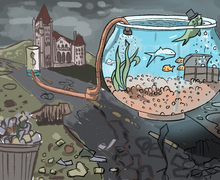Starting over: Mitch Browning was hired to fix the Syracuse offense. The no-nonsense coach is not afraid to change everything
Mitch Browning fixed a suspicious gaze upon his offensive linemen as they repeatedly hurtled into one another at an early April practice.
Browning was brought in to repair the entire Syracuse offense, but he doesn’t seem too concerned with the big picture right now.
He hovers over his offensive linemen, peering out from under his blue Syracuse hat. He is wearing blue athletic shorts and a gray sweatshirt, seemingly in defiance of the 40-degree weather that has forced the rest of the SU coaching staff into big blue parkas and highlighter-orange knit hats.
If his dress would indicate he is a no-nonsense coach, his running critique of SU’s linemen confirms the fact. While head coach Greg Robinson claps and cajoles on another field in his upbeat manner, Browning is stern and serious. He’s quick to pick out the slightest imperfections in blocking fundamentals – when a guard fails to keep his elbows tight to his body when delivering a block or a tackle doesn’t form a wide enough base with his feet.
Browning, the most notable addition to an SU coaching staff that nearly didn’t survive last year’s 2-10 debacle, was brought in to shake things up. Brought in to repair an offense that ranked 114th out of 119 Division I teams in total offense. To repair a mistake-ridden line that allowed 54 sacks.
His solution is simple. Start over.
‘We changed the system, we changed the technique, we changed everything,’ Browning said. ‘We started from scratch.’
That means the end of the West Coast offense, which has staggered through three seasons under Robinson. The pistol, Syracuse’s hybrid shotgun formation? Forget about that, too. (‘I don’t know anything about the pistol,’ Browning said.)
Browning has slashed pages out of the playbook. He’s set about installing the simpler system he presided over during his seven years as offensive coordinator at Minnesota. A balanced mix of power runs and pass plays that produced the top five offenses in Golden Gopher history.
And in the process, everything on the SU offense – from the lineman’s stance to the proper way to deliver a block – has been questioned by Browning in an attempt to turn around this Syracuse offense before the Robinson regime runs out of time.
So if Browning, SU’s third offensive coordinator in four years, seems like a taskmaster on the field, it’s because he knows the Orange can’t afford the mistakes that plagued last year’s sloppy group.
‘More games are lost than they are won by the opponent at the end of the day,’ Browning said. ‘They need to know that, no, it’s not OK to jump offsides. It’s not OK to drop the football. It’s not OK to throw a bad pass. It’s not OK to block the wrong guy or make the wrong call up front.’
Those errors were common last year, when the Orange too often took itself out of the game with early miscues. Browning knows this. He sat in Iowa’s Kinnick Stadium last Sept. 8 and watched the Syracuse offense muster 103 yards in a 35-0 beating. He watched the SU offensive line get pushed around and the offense commit penalties.
Syracuse fans endured a year’s worth of similar mistakes from SU, culminating in the departure of Brian White after a two-year stint at offensive coordinator.
Browning abhors mental mistakes like the ones he saw in Iowa. Any coach does. But Browning’s offense is predicated on avoiding those errors.
While newer schemes like the West Coast and spread offenses rely on complex plays and fancy verbiage, Browning keeps his system simple and the playbook thinner. He spends time teaching fundamentals, like blocking. The theory is if the players are fundamentally sound and control the line of scrimmage, it doesn’t matter what play is called.
‘I think things are simplified in a lot of ways,’ SU’s rising junior quarterback Andrew Robinson said. ‘There’s definitely more of an emphasis on running the ball. Establishing a balance between the run and the pass.’
Browning will tell you the key to any offense, and especially his system, is the offensive line. The line’s struggles doomed Syracuse last year, too often leaving Andrew Robinson on his back.
That’s why Browning spends so much time with SU’s offensive line. He sees the playmakers – a stacked group of running backs and an all-Big East receiver in Mike Williams – and assumes if he fixes the offensive line, he can fix SU’s offense.
Knowing this, it’s understandable why Browning is so neurotic when it comes to his linemen’s fundamentals. Coupled with his straight-shooting nature, Browning has no problem calling his players out.
Ryan Durand found that out in a hurry. The first time the SU senior guard ever met Browning, the coach invited him into his office, only to spend the next several minutes confronting Durand about a missed assignment that led to sack in a September loss to Illinois.
‘He was just like ‘What the hell were you doing?” Durand said. ‘That doesn’t happen very often. I was like, ‘Oh, here we go.”
But more than just blocking technique is being refined. Browning issued his much-publicized 300-pound edict – that all his offensive linemen had to be at or around 300 pounds or they wouldn’t play.
That was just an extension of the discipline Browning preaches on the field. Overweight players get tired. Tired players make mistakes, and Browning won’t let his offense have many of those.
‘He wants things done the way he wants them done,’ said rising sophomore guard Adam Rosner, who has lost 30 pounds since Browning’s arrival, down from 330. ‘You mess up once? That’s alright. You mess up twice? He starts getting angry. You mess up three times? He’ll kick you in your butt. He’s very focused.’
The same mandates helped Browning and former Minnesota head coach Glen Mason turn the Golden Gophers into one of the most consistent offenses in the nation. Minnesota ranked among the top 35 offenses in the nation in each of Browning’s seven seasons as offensive coordinator.
‘The success we had offensively, especially running the football at Minnesota, which many would say we ran the football consistently better than anybody in the country,’ Mason said. ‘That was really a result of Mitch not only being the architect but the captain that steered that ship for many years.’
Browning’s offensive philosophies have their root in Mason. The two coached together for 21 years, during which time Browning took quickly to Mason’s simplified offensive strategy that employed an effective running game behind a cohesive, fleet offensive line.
The apex came in 2003, when Minnesota produced a Big Ten-record 6,430 yards of offense behind current NFL running backs Laurence Maroney (whom Browning recruited) and Marion Barber III. That year Browning was a finalist for the Frank Broyles Award, given annually to the top assistant coach at the NCAA Division I level.
In one game that season, Minnesota rushed for 424 yards in a narrow loss to No. 20 Michigan. The day after the game, Mason got a telephone call from legendary former Michigan head coach Bo Schembechler.
‘He said, ‘Coach Mason, I never thought I’d see the day Ohio State or Notre Dame would run for 424 yards against Michigan, let alone Minnesota,’ and he hung up,’ Mason recalled. ‘I went into the staff room and said, ‘Bo Schembechler just called, and I think he gave us a compliment.”
More specifically, it was a compliment to the offense Browning had played a preeminent role in building.
After all, it was Browning who called the plays. Browning who took the recruits shunned by Big Ten powerhouses – the ones who were 10 pounds too light or a split-second too slow – and turned them into disciplined, technical machines. Browning who crafted an offense at Minnesota that was fundamentally sound.
‘We won in Minnesota because we were a well-coached team,’ Browning said.
But those offenses lost at least a bit of their luster, and Mason was fired in 2006 after a 6-7 season. Browning wasn’t retained, and after taking a year off, he got a phone call from Robinson, who had twice previously tried to lure Browning to Syracuse (the two met as assistants at North Carolina State in 1980).
Browning bit, and thus began the overhaul that now is gradually taking place as spring practice crawls along.
If Browning’s excessively critical, it’s because he feels he needs to be. He knows the unstable footing this SU coaching staff is on, that the pressure to win is as acute as it’s ever been around Syracuse.
There won’t be the grace period that Mason’s system got in Minnesota, when it took two sub-.500 seasons before the Golden Gophers managed a winning year. And, for the first time in 21 years, Browning won’t be able to defer to his mentor Mason. To install a completely different system and expect immediate results may be asking too much from Browning.
‘Let’s face it. I think anybody that knows anything about this program knows that the future is right now and we have to win right now,’ Browning said. ‘And to be honest, there’s no reason why we can’t.’
Time will tell if Browning is able to morph Syracuse’s offense, to cure its propensity to for drive-killing mistakes. For now Browning, like Robinson, will settle for calling his offense ‘a work in progress.’
All he can do is continue to pick apart his linemen’s techniques and preach his new system in the hopes his players buy in.
If they don’t, Syracuse might be starting from scratch again next year.
‘If we can improve fundamentally and we can improve controlling that line of scrimmage then we’ll be a drastically improved football team,’ Browning said. ‘And we’re not there yet by any stretch of imagination, but we’re making improvement.’
Published on April 13, 2008 at 12:00 pm





